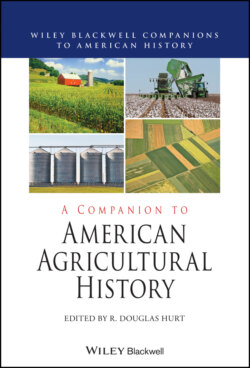Читать книгу A Companion to American Agricultural History - Группа авторов - Страница 31
The Transportation Revolution: Initial Stage, 1815–1830
ОглавлениеAmericans and Europeans heard and witnessed the boom of the rise of the cotton kingdom; many were staggered by the wealth cotton was bringing to the plantation lords. The boom that was neither heard nor remarked upon was the northern agricultural economic explosion. The northern boom was ignored, first, because it came to be overshadowed by the arrival of early industrialization along the east coast, and, second, it was democratic. Northern agriculture was based on the family farm, its foundation laid 1790–1830, its flowering coming 1830–1890. The family farm was democratic because it did not have titans like industrial manufacturing and it did not have aristocrats or slaveholders dominating thousands of workers or tenants; instead, northern agriculture was composed of small holdings that produced modest incomes for its farmers—but there were hundreds of thousands of them. The economic result of this circumstance was a huge internal market that spurred the country to extraordinary levels of material growth.
The first condition that allowed for the surfacing of the economic power of the family farm was a rising urban population on the northern Atlantic coast. New York, Boston, and Philadelphia were growing fast and required foodstuffs for their populations. This circumstance was not replicated in the Atlantic seaboard South which did not in these years exhibit any notable urbanization. Moreover, the northern coastal Atlantic states were generally poor agricultural areas and the region began to register a food deficit (Meyer 2003). Thus the northern farmers who migrated west would have the opportunity to send crops east, but only if transportation systems were built that enabled them to do so. The two transportation advances that occurred between 1815 and 1830 were the steamboat and the Erie Canal.
For westerners, the great artery of commerce was the Ohio–Mississippi River system, by which goods from western Pennsylvania and the Northwest could reach New Orleans. This was accomplished prior to 1815 by rafts, flatboats, and keelboats. Going down the river was easy enough, but the return journey, accomplished by walking, might take 4 months. In 1807, Robert Fulton invented the steamboat on New York’s Hudson River. Steamboats, however, came to be primarily employed on the Ohio–Mississippi River system and by 1830 dominated travel of people and goods (Gudmestad 2011).
The second great transportation enterprise that changed the northern economy was the Erie Canal. New York Governor DeWitt Clinton argued for it, the legislature approved it, and the “great ditch” started construction in 1817 near Albany and ran 363 miles to Buffalo. Finished in 1825, the Erie Canal was an economic miracle. It opened in sections, and as it did so commerce flourished as farmers took their produce for shipment to Albany and then down the Hudson River to New York City. The impact of the Canal upon farmers was immediate and stimulated other states to copy New York, unfortunately in unwise speculative ventures that were to explode in bankruptcy in the aftermath of the Panic of 1837 (Sheriff 1996; Alasdir Roberts 2012).
One only begins to see the changes in northern agriculture by 1830. Nonetheless, by 1830 two major agricultural booms had occurred. One was in the Gulf states, the rise of the cotton kingdom. The other began 1815–1830 and consisted of the spread of the family farm in the north and the resulting prosperity and growth it portended. These two booms, however, had fundamental differences, and the antagonisms between them would become apparent in the 1850s.
